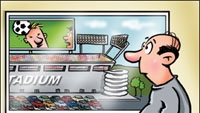HD: A branding vehicle
Convergence can mean many things. In television, we usually think of convergence as broadcast, IT and telecoms coming together at the technology layer. During a recent event at London's Emirates Stadium, I experienced a different form of convergence: convergence at the presentation layer.
The owner of Emirates Stadium — Arsenal Football Club — has whole-heartedly adopted HD. Games are shot and aired in HD, which is nothing new, but as part of developing a relationship with the fans, the club has built a multimedia experience.

Although clubs gain a big portion of their overall revenue from television rights, fans also contribute to revenue through ticket, merchandise, and food and drink sales. So obviously, one way to improve revenue is to increase the dwell time at the stadium.
Older football clubs find that fans wait in nearby bars watching sport on big screens until 10 minutes before the game. Then there is a mad rush for seats. A similar rush happens after the final whistle.
Arsenal Football Club found that by providing a big screen overlooking the pitch, as well as 450 HD screens throughout the hospitality areas, fans will arrive an hour early and spend more money at the stadium. The stadium screens air three channels with live sport, exclusive interviews and pre-match coverage, as well as general marketing messages — all in HD.
Sporting content drives consumers to subscribe to premium channels and purchase big screen TVs. The provision of advanced A/V facilities at the ground along with digital signage is just an extension of this. But it doesn't stop there. Clubs have pioneered niche satellite channels, sophisticated Web presences and streaming video.
One speaker at the Arsenal event was from Porto's Dragäo stadium and described the dual use of the large screen display. Being easily visible from the adjacent highway, a large screen display can be used for adverting outside match days.
Get the TV Tech Newsletter
The professional video industry's #1 source for news, trends and product and tech information. Sign up below.
Sport does have the luxury of high revenues. Fans are prepared to spend a considerable amount of money to follow their favorite team. As a result, we see business opportunities from convergence appearing in the sporting sector. We can expect such convergence to trickle down to other sectors.
Convergence has another aspect. Sony provided the HD equipment at Emirates Stadium, so the installation stands as a marketing vehicle for Sony's displays. And who buys large flat screens? Sports fans.
For a stadium owner like Arsenal Football Club, the presence of all this HD video equipment means that there are more opportunities to use the stadium as a general-purpose events space. This convergence of signage with broadcast television leads to a synergy that provides business opportunity, but not for the broadcasters. The club becomes the publisher and facilitator.
Now that sport has become a brand — from the Olympics to Manchester United — are broadcasters no longer the first choice as a distribution channel for sporting content? Negotiating rights has always been tough, but new distribution technologies like IPTV may make self-publishing a future option for sporting bodies.
Emirates Stadium is an example of how HDTV can be used to market two brands: the club and a consumer electronics manufacturer. Yet again, technology advances threaten the status quo.
Send comments to:editor@broadcastengineeringworld.com
